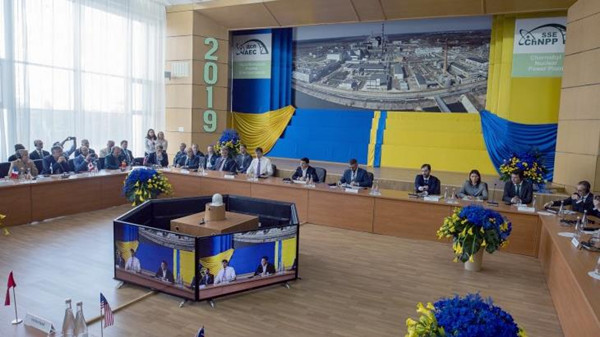Ukraine seeks to improve Chernobyl's image
Ukrainian President Volodymyr Zelensky has signed a decree that sets out plans to develop the Chernobyl exclusion zone as a site for tourism, including new walking trails and enhanced mobile phone reception.

Ukrainian President Volodymyr Zelensky announcing the new decree on Chernobyl (Image: Ukrainian President's Office)
"Chernobyl has been a negative part of Ukraine's brand," Zelensky said. "The time has come to change that."
Zelensky announced the decree during a visit to Chernobyl on 10 July, where he participated in a ceremony to mark the official handover of keys to the Ukrainian authorities for the New Safe Confinement, which shields unit 4 of the Chernobyl nuclear power plant. The event was organised by the European Bank for Reconstruction and Development.
The decree - titled "On the development of areas affected by radioactive contamination due to the Chernobyl disaster" - represents the start of the exclusion zone's transformation, Zelensky said, "into one of the growth points of the new Ukraine".
The document helps in particular, he said, with the government’s strategy for the development of the site as a tourist destination.
"Unreasonable restrictions", such as the prohibition on filming in the area, will be lifted, he said, and Ukraine will "popularise" tourism of Chernobyl at international events to change the image of the area as a ghost town.
"We must give this territory of Ukraine a new lease of life. Until now, Chernobyl has been a negative component of the Ukrainian brand. It's time to change that," he said. "We must showcase this place to the world: to scientists, ecologists, historians, tourists," he added.
The decree will oblige officials and law enforcement agencies to coordinate visits to the Chernobyl zone within three calendar days of request through electronic ticketing. If an application for a ticket is refused, the applicant will be notified the day before, and not at the checkpoint.
"Unfortunately, the exclusion zone is still a symbol of corruption in Ukraine," he said, "in the form of bribes that security officials collect from tourists, as well as the illegal export of scrap metal and the use of natural resources. We will stop all that very soon. Let's finally stop putting tourists off and instead turn the exclusion zone into a scientific and future tourist magnet."
In addition, Ukraine plans to offer training events in the Chernobyl exclusion zone "for the prevention and elimination of accidents" to its partners from the European Union and NATO countries, he said.
Urban myths
On the same day the decree was announced, a world leading cancer specialist wrote an article for the The Sydney Morning Herald to address the fact that scaremongering about Chernobyl "continues unabated".
Gerry Thomas, professor of molecular pathology at Imperial College London, has conducted research into the health effects of the Chernobyl accident for 27 years, and written reviews of the impact of radiation exposure following nuclear accidents. In her article this week, "Let's separate the urban myths from Chernobyl's scientific facts”, she writes about 'radiophobia' - a fear of exposure to radiation.
More than 30 years after the accident, "some misguided individuals and organisations are still peddling conspiracy theories", she wrote.
"Human beings inhabit a naturally radioactive world. If we had not evolved protective mechanisms to deal with the effects of natural radiation, we wouldn't be here. We will all be exposed to between 2 and 3 milliSievert (mSv) of radiation every year from our natural environment. We all ingest about 2 micrograms of uranium every day, and uranium is present in shampoos and sea water. While we accept the individual risk associated with the use of radiation for medical diagnosis and treatment, there seems to be less general acceptance of exposure to much lower levels of radiation when it is associated with nuclear power plant accidents.
"The major difference between the scientific facts and the urban myths around Chernobyl is that the science is concerned with attribution, rather than association. Death is inevitable for all us, but what kills you can be attributed to many different things. So why should we reallocate public funds towards properly conducted scientific studies, only to ignore them in favour of conspiracy theories?
"If you want our planet's future to be decided by scientific fact instead of urban myth, including using zero-emissions nuclear energy, it's important to look at nuclear risks in a clear-eyed and objective way. In the interests of reducing risk for current and future generations, it's time to ditch the fear campaigns and get behind nuclear power."
- China Institute of Atomic Energy
- Nuclear Power Institute of China
- Southwestern Institute of Physics
- China Nuclear Power Operation Technology Corporation, Ltd.
- China Nuclear Power Engineering Co., Ltd.
- China Institute for Radiation Protection
- Beijing Research Institute of Uranium Geology (BRIUG)
- China Institute of Nuclear Industry Strategy (CINIS)
- China Nuclear Mining Science and Technology Corporation


